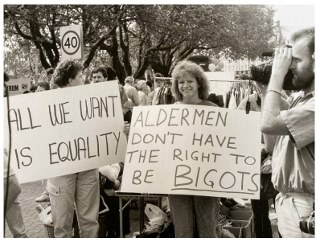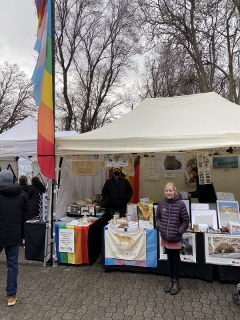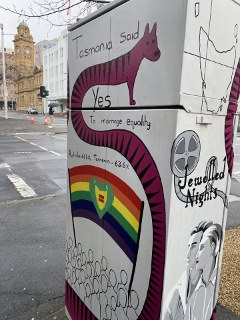Gay Rights Protest
Find out the Introduction for the Salamanca Protest in this Short Video
Salamanca Protest, 1988
One person made an anonymous complaint of the Tasmanian Gay and Lesbian Rights Group's (TGLRG) presence at the market and so the council told the TGLRG to leave. But the TGLRG knew what they were doing and believed it was right. Next the Council warned the TGLRG that if they came back there would be arrests. But they were tired of oppression and wanted the law changed. Then the arrests started. By December, 130 people had been arrested.
“Sometimes they would leave us in the paddy wagons for a really long time... Sometimes when they drove to the police station, they would drive really fast and roughly so we would get thrown around in the back of the paddy wagon.” - Richard Hale, protester.
News of the protest spread across the country “Tasmanian police arrested 13 supporters of gay law reform yesterday for trespassing on local government property.” - The Canberra Times 30th of October 1988. Tasmanians were having their eyes opened to change.
Toonen V Australia
“I could be legitimately tossed out because of those laws. They are an invitation for people to discriminate against me.”” - The Canberra Times, 16th of April 1994 (Referring to Nicholas Toonen)
Nicholas Toonen was a Tasmanian gay activist. On the 25 of December 1991, he issued a complaint to the UN’s Human Rights Committee. He said that the law – which essentially made it illegal to be homosexual in Tasmania – was unfair and a breach of his privacy. At any given point, with only suspicion, police could come into his house and arrest him. He said that it helped people discriminate against him for example: ‘It’s wrong to be gay, the law says so.’ It also went against the International Covenant on Civil and Political Rights (ICCPR), an overarching UN document. In 1994 the Human Rights Committee decreed he was right and advised Tasmania to repeal their laws that went against the ICCPR. Tasmania did so in 1997 - 9 years after Salamanca – becoming the last state to do so.
The example was suggested to me by Lionel Nichols, Human Rights Lawyer as an example of legal protest - protesting via the legal system.
The Legalisation of Same-Sex marriage
In Australia all consenting adults can marry. But that hasn't always been the case. In 2004 John Howard's government changed the law so it defined marriage as: ‘the union of a man and a woman to the exclusion of all others, voluntarily entered into for life’ But in 2017 oodles of people showed their support for gay and lesbian peope in the form of protest. There was a plebiscite – should the law be changed to allow same-sex couples to marry? 61.1 percent of people voted yes to marriage equality. The law now defines marriage as 'a union of two people'. This was a huge milestone in gay rights.
"It was generational change you know? It's taken from 1988 when we started changing the law, and then the law changed in 1997 and then it was 2017 [Same Sex Marriage] so that's like another 20 years, 9 years of campaigning to make gay law reform, then there was another 20 years before marriage equality. So we kind of went from being criminals in private to being able to publicly commemorate our love for each other on an equal footing as heterosexual couples who wanted to marry. It's a whole generation."
Richard Hale, protester in Salamanca.



